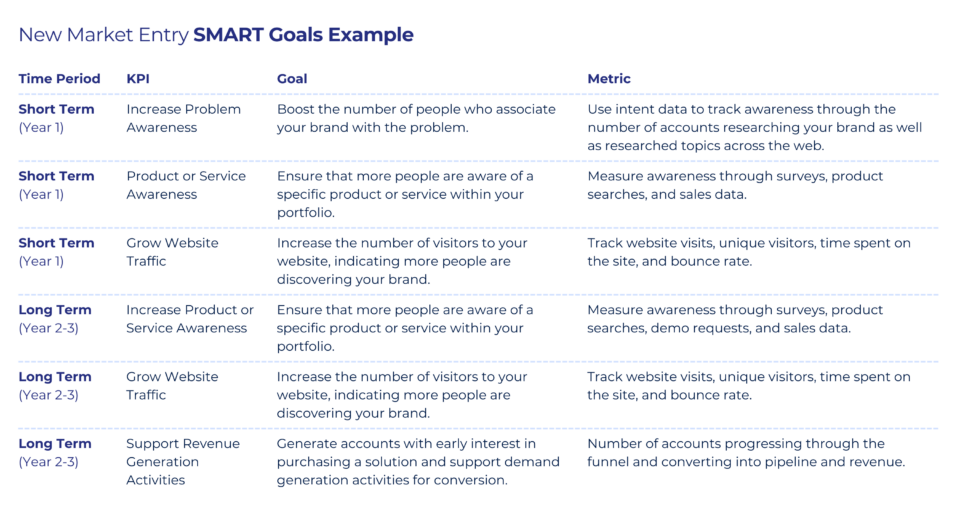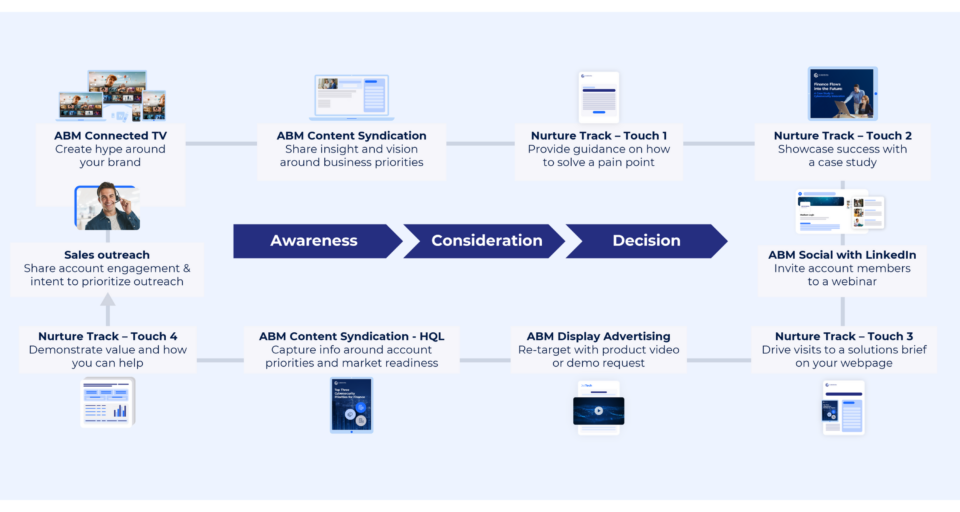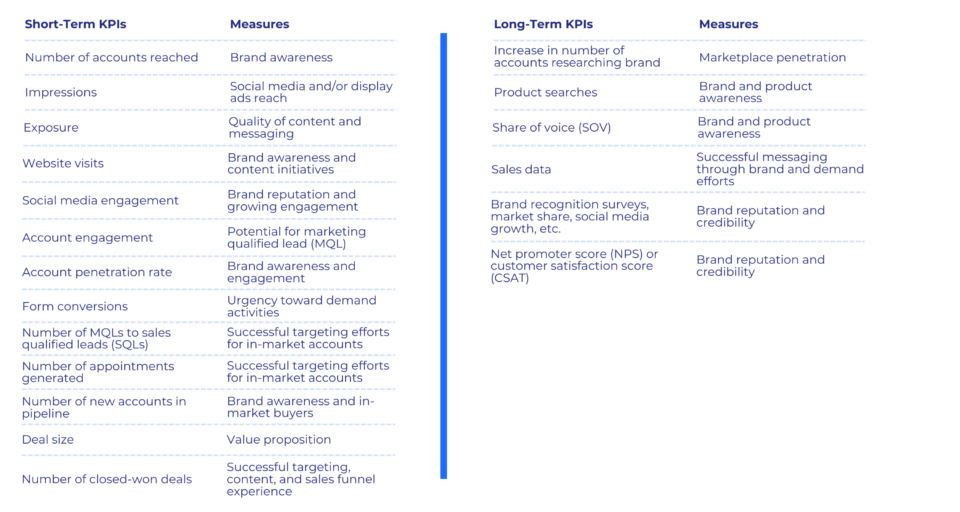
It’s become increasingly important for brands to be visible to their buyers earlier in the buying process. Forrester notes that we’ve entered the “buying group era,” where decisions are made as a collective of B2B buyers who conduct their own research. Yet this presents an issue: When buyers finally engage with your sales team, they’re closer to finalizing their decision versus discovering what you have to offer.
Brand building has become crucial: To be on that “Day One” list, you need buyers to be aware of your brand and your solution. And even if awareness for your brand is high, buyers, especially those in a new market, may be unaware that you offer a product or solution that now serves their needs.
According to Forrester’s 2023 Business Trust Survey, “77% of purchase influencers consider brand awareness when deciding whether to trust an organization.” New market entry requires brand awareness initiatives, as familiarity is built over time with consistent messaging. If you only focus on targeting accounts you know are in-market, you lose the opportunity to easily gain more market share by having raving fans, primed to act, in a market you could serve in the future. Yet building brand awareness requires significant resources, and misallocating those resources can lead to wasted budgets and missed opportunities if the effort doesn’t resonate with the target market.
You need to understand how to enter a new market with a splash, yet be able to sustain the investment for optimal results. And with an account-based marketing (ABM) approach, your new market entry strategy is easily replicable as your solution or product expands and grows with your current and future audience’s needs.
What Is New Market Entry?
New market entry campaigns introduce an existing product or new product to a new vertical, geographic region, or target audience. As a new contender in the marketplace, you must consider how to raise your brand awareness in a specific market and against your competitors.
Effective marketing efforts drive future sales by making your brand top of mind when a buyer is ready to make a purchase—even if you don’t have something to offer them yet. For successful market penetration, you need to investigate market size, market needs, and market trends in both your existing market and new market to determine where the business should prioritize product development as the company and product grows.
Brand Awareness Challenges in B2B Marketing
For many organizations, measuring the success of brand awareness efforts has always been a struggle. Brand recognition has an impact on valuation, which we’ve seen across B2B brands like Salesforce, Dell, or Adobe. Brand alone can drive incredible interest and even pave the way to hypergrowth for many companies. Yet linking brand spend to impact on pipeline and revenue has historically been difficult.
Gartner notes that 21% of brand leaders see brand metrics, such as social likes and reach, as actually actionable. Overemphasizing demand generation can create gaps in measurement and attribution, leading to missed opportunities and hindering long-term growth. This often happens when organizations rush prospects in the deal cycle without building the trust necessary to win a deal or form a lasting partnership.
When budgets are tight, brand spend is often one of the first areas to be cut. This leads to a decline in marketing influenced or lifted pipeline and revenue because your brand fades from buyers’ consideration list, making it harder to build trust when demand generation efforts kick in. Another often repeated mistake is using existing campaign materials that speak to buyers with a mature understanding of your offering for audiences who may have never bought a solution like yours, despite otherwise looking very similar to your existing ideal customer profile (ICP).
Other negative consequences of cutting brand spend include:
- Decline in Sales: An obvious reduction in brand awareness efforts, sales can also decline due to brand misperceptions and the responsibility falling onto the sales team late in the sales funnel to build trust and credibility.
- Brand Obscurity: Buyers tend to overlook your brand due to it not being top of mind or not fully understanding your products and/or category.
- Increase Costs for Demand Generation Efforts: As brand awareness fades, demand generation becomes more expensive. Demand generation ends up taking on more costs as it tries to build in the education steps that brand awareness efforts usually provide, which makes it less effective at building urgency toward purchasing your solution.
- Decrease in Customer Expansion Opportunities: Existing customers are more likely to churn or decline cross-sells and upsells as customers switch to or test products from brands they see as more relevant in the market.
- Shift in Market Position: Without strong brand awareness and visibility, you lose the perception that you’re a leader in your industry, which gives competitors an edge.
You need to think of brand awareness activities as not only a visibility driver, but as a revenue driver. As buyers research and become familiar with your brand, they’re primed to enter your sales funnel with more urgency, which impacts your pipeline and revenue growth. Ty Heath, the Director of Market Engagement at The B2B Institute at LinkedIn, emphasizes brand awareness as a revenue driver, saying:

Why You Need an ABM Approach to Your New Market Entry Strategy
ABM keeps your audience’s needs at the center of your campaign. With a multi-channel ABM campaign, you drive awareness and urgency across the funnel by knowing what your prospects need exactly when they need it, wherever they are. In a new market, you need to understand who is on the buying committee as quickly as possible to ramp up your brand awareness initiatives so that the buying committee can seamlessly transition from simply becoming aware of your product to demanding it for their needs.
The buying committee comprises a diverse array of stakeholders, each with their own priorities and concerns regarding the problems they aim to address. These buyers generally conduct their research online, often without direct input from your sales team. As a result, marketers must be equipped to deliver comprehensive information to these well-informed buyers, particularly when entering a new market where establishing brand recognition is crucial.
5 Steps to Create Your New Market Entry Strategy
In five steps, you can quickly navigate new market entry with an ABM approach that allows you to focus on educating your buyers, driving urgency, and optimizing your campaigns to ensure potential new customers receive a unified, consistent experience from initial encounter with your brand to a long partnership with ample expansion opportunities.
Step 1: Define the Goals for Your Market Entry Strategy
For successful market entry, brand awareness campaign efforts play a critical role in driving demand. Defining clear goals for your campaign is essential to measure the success of your initiatives and to ensure that your brand-building efforts align with broader business objectives—of creating urgency that fuels faster sales cycles and larger growth opportunities.
If you’re a large organization with several product offerings in your portfolio, you will need to decide on whether you want to build awareness for your brand, your product, or both. In some cases, your brand awareness could be strong, but your target market may not be associating your product with a specific problem they are encountering. You’ll want to focus on increasing awareness around the use cases you can solve for this particular segment.
Effective campaign goals for new market entry need to follow the SMART framework: Specific, Measurable, Achievable, Relevant, and Time-Bound. Splitting your goals between short- and long-term timelines allows you to put more emphasis on building brand awareness first. Once you gain market traction and visibility, you start fueling your demand generation activities.

To make these goals truly SMART and realistic, look at your historical data from your initial brand launch or previous product launches. Investigate your sales funnel, how long accounts spend in each buying stage, and how personas in your current market engage with your content. As a rule of thumb, you want to align your short-term goals with the average length of your sales cycle to get a representative understanding of your campaign performance.
Step 2: Define Your Target Segments
Entering a new market means you have ample opportunity to connect with new potential customers. Yet, according to LinkedIn, only 5% of your buyers are in-market at any given time. You need to understand who these buyers are—and through ample research, you can quickly define your target customer segments and lay the foundation for the buyer personas that will inform your new market entry campaigns.
Your research toward defining your target segments begins in a familiar place: with your competitors and your current market presence. Researching your competitors allows you to identify the level of brand awareness you need to invest in to gain market traction. A strong indicator of potential prospects is to track the number of accounts researching your brand and competitors over 12–24 months to define your current position and business goals. You’ll want to track these accounts’ research activities on your brand and your competitors against specific solutions to see if the market links your brand to those solutions. If the marketplace doesn’t, then you need to invest in more brand awareness toward showing you offer relevant solutions that help these buyers reach their goals.
Your product marketing team provides valuable insight into your competitors’ unique strengths, what attributes keep customers loyal to them, and where you have any competitive advantages. If your marketing team doesn’t have a product team, you can still conduct competitive research to find this information. Review websites like G2 or TrustRadius to aggregate client reviews and rankings into scores and badges across a variety of categories to identify industry leaders. Gartner research reports provide deep industry insights and rankings across various industries and products. Search engine optimization (SEO) tools like Semrush and Ahrefs can also compare your website’s domain ranking and content statistics against competitors, which lets you quickly identify what competitors are within reach to beat, and where you have content gaps and opportunities to outrank competitors and claim more of the digital marketplace. A strong digital presence, especially in terms of organic search, allows you to gain more visibility, which will catch buyers’ attention as they search for solutions.
Narrowing down on your target segments is two-fold: Part of it is narrowing down on the accounts and buying groups going into market and convincing them why now is the right time to make a change, and why you should be their partner of choice. Part of it is around accounts who are happy with their existing solutions, and vendors who need further education on why they should change. Identifying where accounts fall in your target segments allows you to maximize your resources on the buyers that are most likely to purchase your solution and expose them to your brand to build familiarity over time. Between your marketing toolkit and collaboration initiatives with your sales team—who also understand how your product stacks up to competitors—you can quickly identify target segments to dig into and define as your in-market buyers.
Some of your sales and marketing alignment activities include:
- Collaborating with sales and other marketing teams to align on your ideal customer profiles (ICPs) based on factors like revenue potential, company size, technographic data, strongest verticals, and buying committee personas and demographics.
- Layering intent data into your analysis. This includes account research behavior, trending topics, and engagement with media (like content syndication) to refine your target segments further.
- Identifying from your customer relationship management (CRM) and marketing automation platform (MAP) systems if there are additional accounts that could benefit from brand awareness initiatives. This could be particularly relevant if you offer various solutions and your prospects and/or existing customers are not fully aware of your entire product portfolio.
- Pulling a separate list of accounts matching ICPs and trending on competitors. These accounts have more urgency and could benefit from a mix of brand and demand generation activities to accelerate conversion.
Step 3: Develop Your Content and Messaging
You need to determine your unique value proposition and differentiators that can be used in your content narrative to make your brand stand out against your competition. When you focus on showing how well you know your target audience, you quickly gain momentum toward building trust and credibility in your new market.
To get toward growing your brand position as a (rising) thought leader in this new space, you need to ask the following questions around your audience and competition:

These questions allow you to focus on who the audience is, how your competitors position their solutions, and how you can quickly differentiate yourself in the market.
While targeting immediate buyers is an option, many people rely on their memory to find a solution rather than actively searching. Even then, many buyers won’t remember exactly what your content says—but they will remember how they feel when they encounter your content, messaging, and advertisements.
Consistent messaging over time is key to building brand familiarity. Your advertisements need to create unique, memorable impressions that shape your buyers’ perceptions over time, so that when they become in-market, they will remember your brand. You need a variety of content assets, such as presentations, eBooks, white papers, landing pages, videos, and display advertisements that appeal to various members of the buying committee. Identify what messaging and ABM content will be key for each member of the buying committee, keeping in mind that it needs to be consistent and customer-centric to increase effectiveness. Dig into committee members’ individual concerns and how your product offers a solution that positively impacts department goals, such as workflow or resource allocation, and how these results impact company-wide goals.
Step 4: Build a Brand Experience Throughout the Funnel
The ideal buying journey helps buyers understand how your brand can solve their problems and why they should pick your solution. A consistent message, look, and feel builds trust and credibility. By providing all the elements to help with their decision-making process, you remain a strong contender and accelerate the sales cycle.
The buyer’s journey isn’t linear, and typically involves multiple touchpoints. The reason people don’t always move smoothly from the awareness to decision phases is due to human nature. Humans are unpredictable, and market conditions can quickly cause buying committee members to shift their priorities, which causes them to fall off the funnel or pause indefinitely while others move forward.
Aligning content to the buying stages is key to enhancing the buying experience, as it allows you to focus on what pieces can help move the lever from one stage to the next. But you also need to tap into personalizing your content and messaging.
Personalization, at its foundational level, engages buyers through the delivery of content and messaging that addresses their specific pain points and even potential customer preferences. When employed successfully, personalization helps deliver more relevant experiences across the buying group to ensure there’s a cohesive, consistent view of the brand while also driving a sense of urgency to solve their collective pain points (and, therefore, meet with sales). As the buying group consists of individuals with different priorities, you need your content to meet each buyer persona where they are while addressing their concerns so they can see you as the vendor of choice—the vendor that truly understands them and wants them to be successful.
As a vendor with low awareness, you should have content that covers:
- Key Pain Points and Challenges: Content that taps into what your buyers’ experience and showcases your expertise in the market and your knowledge on how to address their issues, which builds credibility.
- Your Value Proposition: Why should your brand be considered as a potential supplier? What makes you unique? Why should buyers switch to your solution? What value can you bring to the business? What would the experience be like when working with you? These questions inform how you communicate about your unique differentiators, solve pain points and challenges, and create positive momentum for your clients.
Every piece of content doesn’t have to account for every challenge or address every value proposition for every buyer persona. But you need to have answers readily available at the right stage of the funnel to keep buyers engaged. A successful brand-building strategy makes sure that key messages and creative are consistent and repeated across all types of content.

Evaluating your sales funnel’s progression and success comes through collaborative initiatives with the sales team. Both teams need to agree on how to score engagement to determine when accounts become “hot leads” or are picking up speed toward more demand initiatives. Score accounts and prospects based on the level of exposure to your ads and engagement to determine how they are progressing through the funnel and when to introduce demand generation touchpoints. You’ll also need to agree on any promotions or offers that marketing can advertise to prospects or customer success teams can bring to customers who are primed for an upsell or cross-sell in services. These offers help the sales team close deals faster while also helping the company gain more market share quickly.
Step 5: Track the KPIs That Matter Most
New market entry isn’t exactly a one-and-done operation: As the company grows in brand recognition, reputation, and credibility, customers and prospects alike will want more opportunities to invest in its offerings. Regardless of industry, successful companies pave the way toward expansion—whether that’s upsells and cross-sells to existing customers or entering a new market. You need to identify the key performance indicators (KPIs) and metrics that matter most to your business to replicate successful market entry campaigns as the company grows.
Just as you established short- and long-term goals for your campaign, you need to be aware of how certain ABM KPIs and metrics serve your needs throughout the campaign. Short-term brand awareness KPIs give you a good indication on the effectiveness and reach of your campaigns, which you can use to optimize campaign targeting, content and ad performance, and your media mix to maximize its impact throughout the sales funnel. Long-term brand awareness KPIs may seem far away, but establishing them now sets your marketing initiatives up for future success and replication.

Establish Your Brand in New Marketplaces with Madison Logic
New market entry was once a wide-open space, full of buyers you only hope would glance your way when the time was right for them. Now you know how to craft your brand awareness activities so that they always create a clear road in your new market toward your target segments through always-on, multi-channel ABM strategy. Soon enough, you’ll be making the Day One vendor list with ease.
Yet to get that coveted spot, you need to quickly build trust and familiarity throughout your new market. Download the New Horizons: Navigating New Market Entry with ABM Blueprint to go deeper into other aspects of building your new market entry strategy, such as what your marketing media mix should look like across the four primary ABM distribution channels: connected TV (CTV), content syndication, display advertising, and LinkedIn. You’ll also learn more about why a unified brand-to-demand marketing strategy helps ramp up the buyer’s journey.
And when you’re ready to bring your new market entry plan to life, you need to partner with an organization that understands how to grow with your business, helping to turn your target audience list from short-term B2B buyers into high-quality, long-term brand enthusiasts. Madison Logic offers an ABM platform that empowers your target audience segmenting abilities through ML Insights, your measurement capabilities through ML Measurement, and proactive optimization efforts through integrations between your CRM and MAP that lead to your campaigns—and brand—outshining your competitors. Request a demo today to learn how the ML Platform sets you up for new market entry success.


